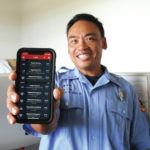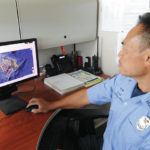The Big Island community now has a tool to respond to sudden cardiac arrest — and save lives.
PulsePoint, a nationwide free smartphone app that connects CPR-trained individuals to patients who suffer cardiac arrest in a public place, was rolled out in November by the Hawaii Fire Department’s Emergency Medical Service.
Though users islandwide have already registered, emergency medical responders are trying to get the word about PulsePoint out to the community.
“We live on a Big Island with limited resources,” said Capt. Mike Lam, of the department’s EMS division. “On average it takes about 8 minutes for an ambulance to arrive on scene, depending on the location of the call.”
That average is significantly higher in rural areas, farther from an EMS-equipped fire stations, such as Milolii, where the app could be a critical tool in saving lives, he said.
With PulsePoint, life-saving CPR can get underway sooner because users get notification of cardiac arrest a few seconds before emergency responders get the call.
“When someone calls 911 and states a cardiac arrest, the dispatchers type in the code for cardiac arrest. When they hit enter in the system, PulsePoint users within a quarter mile of the area are notified and asked if they are able to respond,” said Lam.
The sooner cardiopulmonary resuscitation (CPR) is initiated on a person in sudden cardiac arrest, their chance of surviving increases.
“Pre-ambulance-arrival CPR has shown to be vital because you are mechanically pumping the heart before the ambulance shows up,” Lam explained. “When the ambulance shows up, they can do their intervention.”
American Heart Association statistics show approximately 350,000 people experience sudden cardiac arrest nationwide outside of a hospital setting. Only 12% of those survive. The Big Island, according to data provided by Lam, sees an average of 250-300 cardiac arrest calls annually. Just 8% to 12% of those people survive.
“The reason that’s a low number is because when one is in cardiac arrest, after four to five minutes, there is brain damage,” Lam said. “It’s crucial for bystander CPR for cardiac arrest to get that number up.”
Data from the Resuscitation Academy in Seattle, front-runners in early intervention CPR advancement, found survival rates in King County, Washington, increased to 50% after early intervention programs.
“Our department has taken a multi-pronged approach to increase survival rates for sudden cardiac arrest,” Lam said.
Being a PulsePoint community is the first step.
Currently, Hawaii County and the City and County of Honolulu County are the only PulsePoint communities in the state, with 3,981 communities activated nationwide. The app also works when a person is traveling, meaning a notification could be sent to a person visiting Oahu or another locale to assist with an emergency there.
PulsePoint is not only for CPR-certified members of the community; Lam said it’s for everyone. The app, in addition to guiding the responder to the location and nearest registered AED, also provides pictures and has a metronome to instruct the person on doing compressions.
According to PulsePoint, 57% of U.S. adults say they’ve had CPR training, and most would be willing to use CPR or an AED to help save a stranger’s life. Yet only 11% say they’ve used CPR in an actual emergency, a number PulsePoint boasts the app can increase.
“Our goal is to have every one of us trained in CPR because there will be a time when we are faced with having to do compressions, especially with the statistics of the baby boomer population getting older. As our population gets older, we are going to have to learn this skill,” said Lam.
The Hawaii Fire Department is trying to reach its goal to get more people CPR-certified on the Big Island by providing education to the community.
EMS Capt. Stacy Domingo is in charge of education and has been going out to island schools willing to have her teach faculty and health pathways classes. Recently, she taught students at Konawaena High School, who in turn became co-instructors training the student body in the hands-only CPR program.
Lam recommends the American Heart Association-adopted program known as “hands-only CPR,” which is more for the layperson. The method involves only chest compressions, no breaths, relying on data finding that compression-only CPR still gets oxygenated blood to vital organs prior to reduce the chance of permanent damage.
“We brought 80 mannequins out and in one school day we had three sessions where the student body would come, and with the assistance of the health pathway students doing hands-only CPR to the beat of ‘Stayin’ Alive,’ we trained the students,” Lam said.
Konawaena, Waiakea and Keaau high schools have participated in the hands-only CPR program with Lam on a mission to train all high school students on the island.
Nonprofit groups and charitable organizations in the community have reached out for training, a trend he wants to see continue. The EMS division is interested in teaching hands-only CPR at any event where there is a gathering of community members such as health fairs, Relay for Life, Heart Walk, etc.
“We are an office of four, so our resources are stretched pretty thin, but we want everybody trained,” he said
Beyond getting people CPR-certified and signed up to be a responder via the PulsePoint app, Lam is encouraging any business or organization that has an AED — and is willing to have it made available in case of an emergency — to register it on the PulsePoint AED app, which is separate from the main PulsePoint app.
With the PulsePoint AED app the user can input their AED (automated external defibrillator) location, EMS verifies it and adds the location to the map of available AEDs for the PulsePoint user.
Nonprofit organizations islandwide seeking an AED are encouraged to apply with the Hilo Medical Center Foundation. The foundation also purchased the implementation and funded the initial annual contract to bring PulsePoint online for the Big Island.
“We would like to thank Hilo Medical Center Foundation for generously sponsoring the PulsePoint deployment and bringing this lifesaving mobile app to the citizens at no cost to the county,” Lam said.



